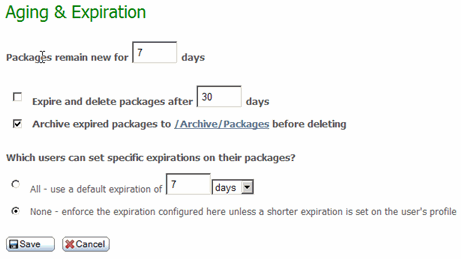
These settings provide aging and cleanup support for Ad Hoc Transfer and are similar to folder aging and cleanup. The administrator can set options that determine how long a package is available to recipients, what happens to a package after it expires, and whether users can set these options themselves. These options apply to all users in the organization. Note that the options can also be set at the group level and at the user level, so that groups and individual users can have settings that differ from the organization setting.
By default, packages are available to users for 7 days, after which they are considered expired; the expired packages are then archived to /Archive/Packages, then deleted from the 'live' packages folder.

The administrator can change the default values. The options are described below:
When a package is sent, the associated files and/or message remain available to recipients for the amount of time specified in 'Packages remain new for nn days', after which the package is expired and deleted. The option to archive before deleting is selected by default, but if not selected, packages are deleted upon expiration. The Administrator can also select to 'Expire and delete packages after nn days' (default is 30 days), which keeps the package available for recipients up through the specified number of days, and overrides the first setting.
The administrator can also choose to let each user set the expiration on their packages, and to set a default number of days. Selecting 'None' enforces the expiration configured in these organization-level options, unless a shorter expiration is set in the user's profile.
When the 'Archive expired packages before deleting' setting is enabled, packages will be added to a nightly archive file before being deleted. The archive file is uploaded to the "Archive/Packages" folder as a zip file containing XML files for each secure message, as well as any attachments included with those messages.
To read the contents of a package archive, please consider using the command-line "Archive Viewer" utility.